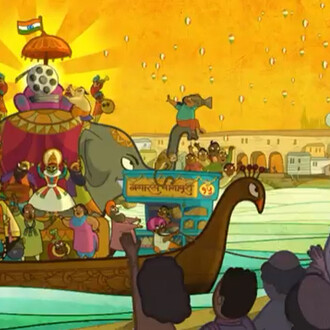The Madre museum presents the first of the projects that will be specially commissioned from the French artist Daniel Buren (Billancourt, 1938) in the course of 2015 to celebrate the relationship between the museum and its public, between the institution and its community. One of the greatest contemporary artists, Daniel Buren’s oeuvre possesses a visual value that is always associated with the theoretical, and whose emblematic element could be summed up in his understanding and use of the term in situ: an expression by which the artist indicates the stringent interrelation between his interventions and the exhibition sites (or urban locations) in which they are set. Daniel Buren’s project for the Madre is structured as a number of interrelated chapters: from April to August 2015 the artist will intervene in the Re_pubblica Madre gallery with the major in situ installation entitled Like Child's Play (2014-2015, in collaboration with the Musée d'Art Moderne et Contemporain, Strasbourg).
With this first intervention Buren welcomes visitors to the large gallery on the ground floor of the museum, converted into a play area with a veritable game of life-size constructions, or a kindergarten on the scale of the environment, made by assembling some one hundred modules of geometric forms and colors inspired by the solids of the German pedagogue Friedrich Wilhelm August Fröbel: wooden spheres, cubes and cylinders heighten the cognitive potential of play in relation to language, encouraging children to engage in a participatory and community discovery of reality and their expressive capacities by stimulating faculties such perception, tactile exercises, construction and deconstruction. On entering the installation, visitors find themselves faced with a potential reality, which enables them to rebuild the world around them with a renewed sense of wonder and childlike amazement. The work, the fruit of a collaboration between the artist and the architect Patrick Bouchain, is thus presented as a subtle inner dialogue with architecture, which becomes almost living and performative: visitors are able to walk inside a city made up of hypnotic circles (on which appear the 8.7 cm stripes which are the recurrent and distinctive hallmark of Buren’s works), colored arches, cylindrical towers, square bases and triangular pediments arranged symmetrically as if they were part of the museum architecture, finally endowing it with its hypothetical and alternative reconstructive potential. What the observer sees is in fact a composite landscape, the reproduction of a true miniature city that relates the real city (which is as if embodied into its archetypal forms within the museum) with an imaginative city that arises before our eyes: an almost metaphysical city that is gradually articulated as a stroll through color leading from an initial chromatic kaleidoscope to pure white, and which one can traverse with the eye following a rhythmical and vertiginous perspective. Inscribing works in the context in which they are exhibited, relating to the social mission that motivates the museum institution, counterpointing a modernity that does not seek a contrast with the urban sphere or the historical dimension but enhances its matrix: this is the significance of the expression in situ from which this work arises, like all the artist’s works. Over the years, Buren has used a great variety of materials, while the scope and context of the works themselves have also differed greatly, ranging from museums to galleries, from monuments to urban areas, from natural sites to landscapes, but maintaining a harmonic correlation between all these elements as the constant axis of their plastic conception, their theoretical dimension transformed into visual representation. The exploration of the dialectic between the various contexts and the work of art, between the existing architecture and new productions, the public and the artist, is then configured for Buren, in this case, as a balanced and comprehensive “jeu d'enfant” (“child's play”): hence the title of the installation.
Trained at the Ecole des Métiers d'Art in Paris, Buren’s research and production have rested since the mid-sixties on his use of striped curtain fabric, with a pattern of alternating white and colored stripes 8.7 cm wide: a choice of rigor and a criterion aimed at the essential, which explores and calls in question the limits of painting. More recently, since the eighties, Buren has gradually combined the creation of works in museum format with architectural installations in public spaces, working with exceptional continuity and coherence in his pluralistic approach to the context for the presentation of his works in situ. As one of the most influential exponents of historical reflection on institutions developed in the sixties and seventies and termed the Institutional Critique, Buren has close ties with the city of Naples, where he has worked on several occasions (as in the Palazzo dell'Arin now ABC in the Ponticelli quarter and with a solo exhibition at the Palazzo di Capodimonte in 1989). After his participation in some of the most important exhibitions of recent decades, from When Attitudes Become Form (1969) to various editions of Documenta (1972-1982), in 1986 the artist took part in the Venice Biennale, being awarded the Leone d’Oro for the best national pavilion. Solo exhibitions have been devoted to his work in the world’s most important museums. Notable among his many in situ works are Les Deux Plateaux in the main courtyard of the Palais Royal (1986) and Excentrique(s), also in Paris at Grand Palais on the occasion of Monumenta (2012).



















